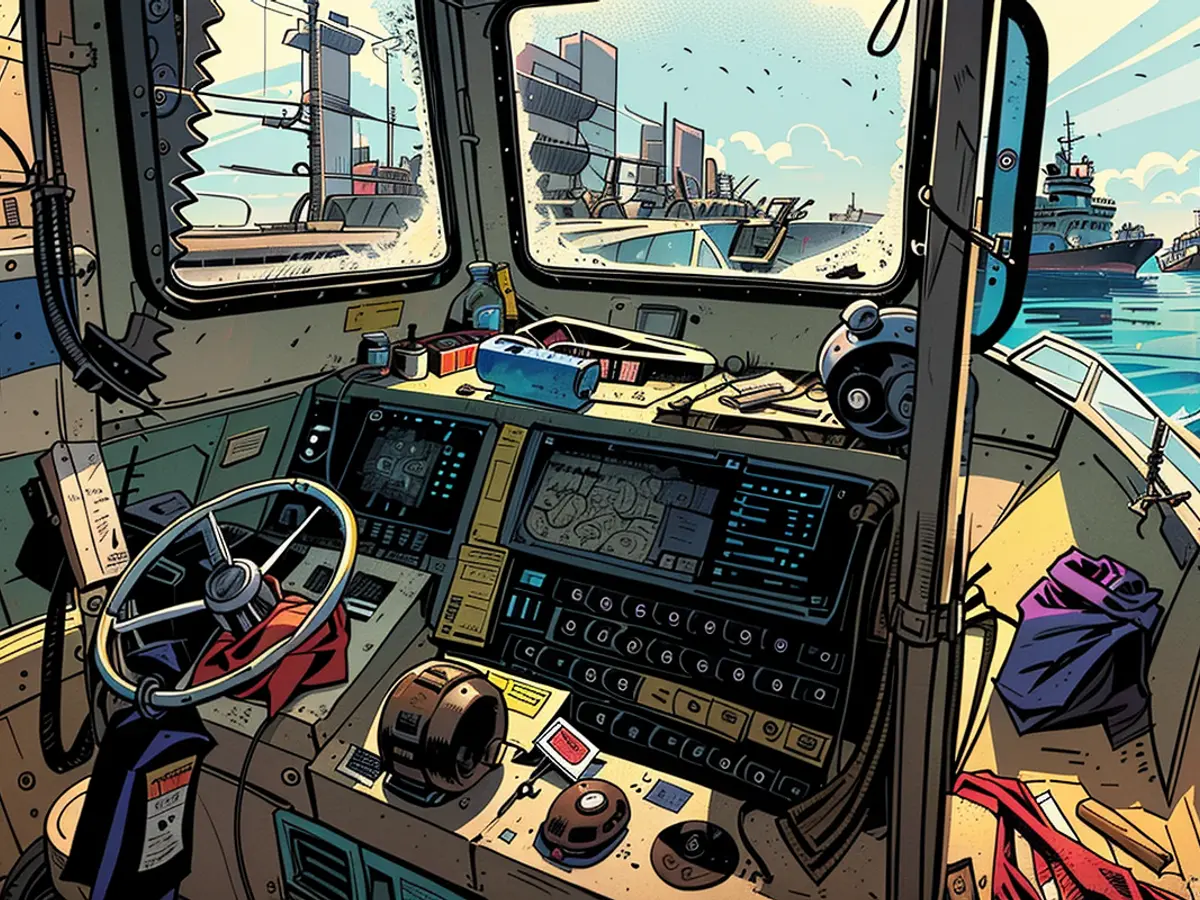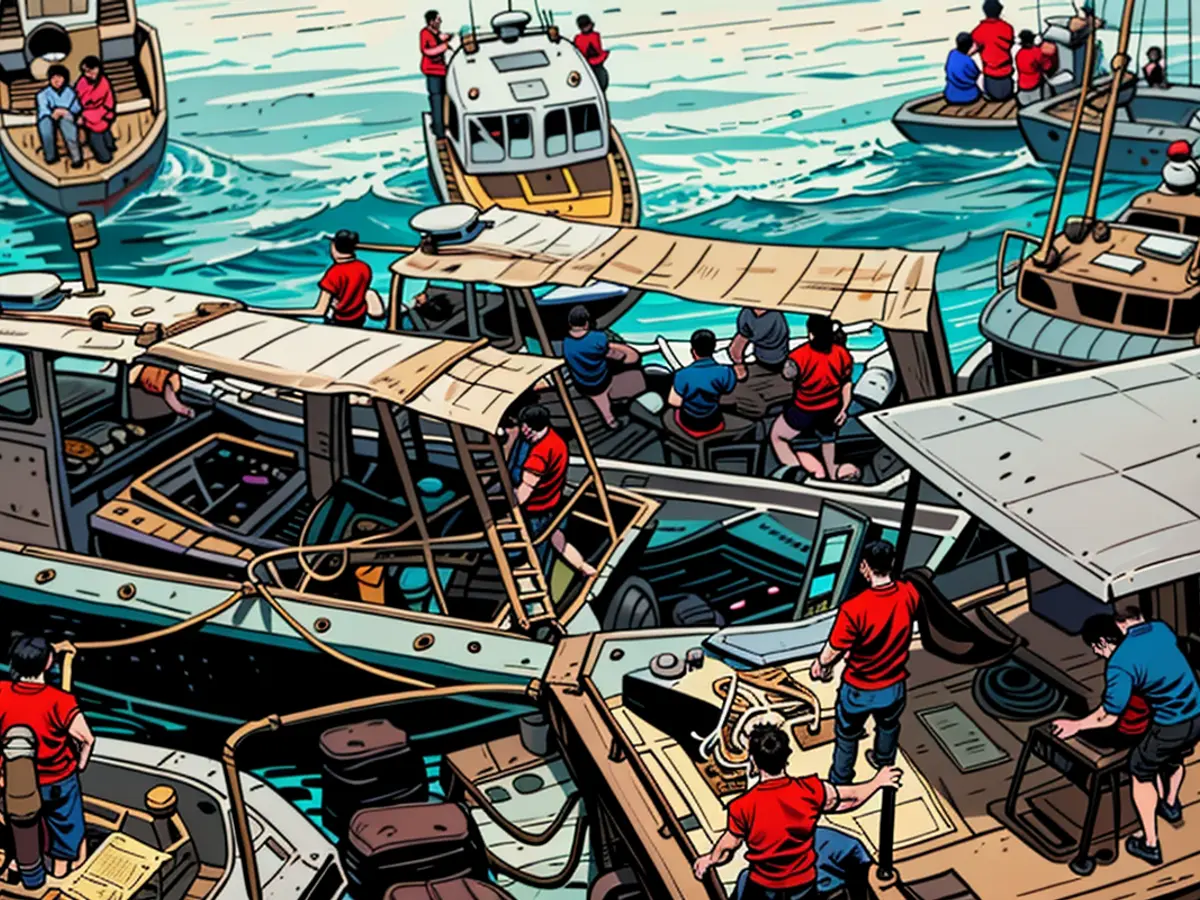"Philippines alleges China's deployment of edged weapons in significant escalation within the South China Sea"
Footage unveiled by the Philippine military on a Thursday depicted Chinese coast guard personnel waving axes and other sharp or pointed tools against Filipino soldiers, and slicing their rubber boat, according to Manila, in a "shameless act of bullying."
The Philippines and China have been trading blame for the encounter near the Second Thomas Shoal in the contested Spratly Islands on Monday, which transpired during a Filipino mission to replenish its soldiers stationed on a beached World War II-era warship, symbolizing Manila's territorial ambitions over the archipelago.
This incident is the latest in a string of persistent standoffs in the resource-rich and strategically strategic waterway.
However, the events captured in the most recent footage signal a newCHECKPOINT in the longstanding disputes, with China deciding on more openly aggressive actions, which analysts claim, are deliberately designed to assess the extent to which the Philippines and its principal defense partner – the US – will respond.
The Chinese Foreign Ministry stated on a Wednesday that the "law enforcement measures" executed by its coast guard during the confrontation were "professional and restrained," and "no direct actions were taken against Philippine personnel."
Collin Koh, research fellow at the S. Rajaratnam School of International Studies in Singapore, stated it was unusual for China’s maritime law enforcement to board a Philippine naval vessel.
"They may be rubber boats, but it doesn’t alter the fact that they are Philippine Navy vessels, and in accordance with international law, they are granted prerogatives equivalent to sovereign immunity," Koh explained. "This is alarming, as it could even be interpreted as an act of war."
Boats ‘ransacked’
At a press conference on a Wednesday, senior Philippine military officials reported that the Chinese Coast Guard officers "illegally boarded" the Philippine inflatables, "looted" seven dismantled rifles stored in their cases, "damaged" outboard engines, communication, and navigation equipment, and took the personal cellphones of Filipino personnel.
"They deliberately slashed our inflatables using knives and other pointed tools," said Alfonso Torres Jr., commander of the Armed Forces of the Philippines (AFP) Western Command.
A Philippine Navy crew member on one of the inflatables lost his right thumb when the Chinese Coast Guard rammed it, Torres stated.
China’s Coast Guard also deployed tear gas, "blinding" strobe lights, and continuously blasted sirens, according to the AFP.
"Only pirates behave this way. Only pirates board, steal, and wreck ships, equipment, and possessions," General Romeo Brawner Jr, Chief of Staff of the Armed Forces of the Philippines, said in a statement.
"The Chinese Coast Guard personnel had bladed weapons and our personnel fought bare-handed. That's what truly matters. We were outnumbered, and their weapons were unanticipated, but our personnel fought with all their might," Brawner added.
Mutual defense treaty
The events in the South China Sea carry significant implications for the US, which has a mutual defense treaty with the Philippines that extends back decades.
The latest skirmish marks the initial encounter between the two countries since a new law in China went into effect on a Saturday, empowering its coast guard to seize foreign vessels and detain crew members for up to 60 days without trial.
It also happened just weeks after Philippine President Ferdinand "Bongbong" Marcos Jr. declared that the loss of any Filipino life in the waterway by another nation would be "extremely close" to an act of war.
Marcos has advocated for closer relations with the US, which has repeatedly emphasized its "unwavering commitment" to a 1951 mutual defense treaty between the US and the Philippines, which mandates that both parties support each other if either is assaulted by a third party.

US State Department spokesman Matthew Miller stated on a Monday that the “United States stands with its ally the Philippines and condemns the escalatory and reckless actions” by China.
In a phone conversation with his Philippine counterpart Enrique A. Manalo on a Wednesday, US Secretary of State Antony Blinken stated China’s actions "undermine regional tranquility and emphasized the United States’ unwavering commitments to the Philippines under our Mutual Defense Treaty."
Derek Grossman, a senior defense analyst at the RAND Corporation, a US-based think tank, stated the footage released by the Philippines "plainly reveals a Chinese attack on Philippine military assets," which, according to Washington and Manila’s defense agreement, would trigger mutual defense obligations.
"Nevertheless, in practical terms, the Philippines itself would need to instigate a move to activate (it) before the US would intervene militarily," he said.
China claims "undisputable sovereignty" over nearly all of the South China Sea, and most of the islands and sandbars within it, including numerous features that are hundreds of miles from mainland China. Numerous governments, including Manila, contest these claims.
In 2016, an international tribunal in The Hague ruled in favor of the Philippines in a groundbreaking maritime dispute, which determined that China had no legal foundation to claim historic rights to the majority of the South China Sea.
However, China has disregarded the ruling. Instead, it has escalated its maritime territorial claims, with China Coast Guard ships – reinforced by militia boats – involved in multiple clashes in the past year that have damaged Philippine vessels and seen Filipino sailors injured by water cannons.
Philippine ‘restraint’
The choice by China's Coast Guard to use bladed weapons in the latest South China Sea confrontation has evoked comparisons with clashes between China and India on their contested Himalayan border, where soldiers on both sides have engaged in intense combat using sticks, rocks, and their bare hands.
Here's a different take on the situation:
"These individuals are well-versed in conflict situations. They intentionally held back from responding aggressively towards the Chinese, according to the statement. It appears they've been explicitly instructed not to engage in a physical confrontation with the Chinese, no matter the circumstances, to prevent the situation from escalating."
The recently publicized video footage from the Philippine military reveals an intriguing detail - the skirmish happened right beside the BRP Sierra Madre, an older landing craft from the US Navy, taken over by the Philippine Navy. This vessel was purposely grounded in 1999 and now flies the Philippine flag to strengthen the country's territorial claims over Second Thomas Shoal.
Koh pointed out that this is the closest the Chinese Coast Guard has ever been to the BRP Sierra Madre.
"Under ordinary military protocols, the garrison would've opened fire with warning shots," Koh explained. "But the fact that this altercation didn't escalate further is due to the Philippines showing incredible self-restraint. That's a clear-cut fact."
China, as per Koh, is testing the boundaries of both Manila and Washington. They're trying to figure out exactly how far they can push before triggering a strong response.
"Beijing is trying to gauge how far the US is ready to commit to defending the Filipinos," Koh stated. "They clearly considered the possibility that these actions could lead to an escalation, but they still decided to take the risk."
Manveena Suri from CNN contributed to this report.

Read also:
The dispute over territorial claims in the South China Sea between the Philippines and China continues, with China's actions being labeled as "bullying" by Manila. This is not the first time such incidents have occurred in the strategically important waterway, which is rich in resources.
In the latest escalation, Chinese coast guard personnel were accused of waving edged weapons and damaging Filipino boats, an incident that took place near the Second Thomas Shoal in the contested Spratly Islands. This area is significant to the Philippines as it houses a World War II-era warship, symbolizing Manila's territorial ambitions in the archipelago.
These events are taken as a new checkpoint in the longstanding disputes between the two countries, with China allegedly adopting more aggressive actions to test the response of the Philippines and its principal defense partner, the US.







